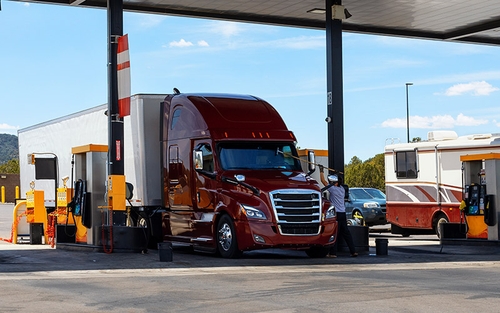How to grow a trucking company: 8 steps to start taking now
May 27, 2025

Estimated reading time: 4 minutes
You took a chance, became an owner-operator and are pleased with the success you’re having. So, what comes next?
Whether it’s exploring different revenue opportunities, expanding your fleet or investing in new technologies, growth is within your reach. Consider these suggestions on how to grow a trucking company to take your business to the next level.
8 tips on how to grow your trucking company
1. Focus on your average revenue per day.
According to American Truck Business Services (ATBS), the most successful owner-operators are ones who focus on increasing their average revenue per day by choosing the best value loads that match the goals of their business.
Owner-operators who drive lots of miles and don’t factor in revenue per mile typically lower their profitability and spend more on operating costs.
To calculate your average revenue per day, think about:
- How many miles you’ll be driving for a load.
- What the revenue per mile is for the load.
- How many days it’ll take to pick up and deliver the load.
- What additional expenses you’ll have (fuel, food, etc.).
2. Track your budget.
If you don’t already have a budget laid out, now is the time to do so. A budget will show how much revenue your business is actually generating and how much money your business is actually spending.
You could use an Excel document to track monthly expenses or a free virtual tool, such as mint.intuit.com or everydollar.com.
Plus, your budget might reveal new ways to save money that you hadn’t previously thought about, such as:
- Improving your semi-truck's fuel economy.
- Taking advantage of tax deductions for owner-operators.
- Calculating your cost per mile to find what your rate per mile must be to make a profit.
3. Think about how to get loads.
If your business isn’t already coming out ahead, you might need to reconsider how you get your loads.
There are many ways to find your loads, including:
- Using a freight broker.
- Working directly with a shipper.
- Leasing-on with a company like Schneider and using their private load board.
- Looking for freight on the spot market.
It’s up to you to choose the option that will work best for your business.
4. Invest in a better truck.
A newer truck can lower your business’ operating expenses because it typically has better MPG and fewer maintenance issues than older models.
You have several options when it comes to upgrading your truck. Some of the most common include:
- Purchasing a brand-new truck from a dealership.
- Buying a newer used truck from somewhere like Schneider Trucks.
- Leasing a brand-new or newer used truck from a place like SFI Trucks and Financing.
Deciding whether to lease a semi-truck versus buying one is an important choice that depends on your financial situation and long-term business plans.
5. Expand your fleet with extra drivers.
Hiring a truck driver to work for you can be a smart way to grow your business. It might feel like a big leap, but the potential revenue increase from having an additional truck(s) hauling freight for your business could be well worth the investment.
Here are a few pieces of advice when it comes to becoming a fleet owner and hiring an extra truck driver(s):
- Find a driver before your business invests in a second truck. You don’t want to purchase or lease a truck only to discover you can’t find a driver to use it.
- If you’re considering hiring a friend or family member to work for you, make sure you think through whether a boss-employee relationship would work for both of you.
- Always interview someone before hiring them.
- Once you’ve hired someone, have them team drive with you for a while before they go out on their own. This way they can see exactly how you want things done.
- If you don’t think hiring drivers is right for your business, you may want to consider working with independent contractors (if you’re operating under your own motor carrier authority).
6. Hire someone to take care of office-related tasks.
You have a lot on your plate as a trucking business owner: finding loads, doing the books, filling out paperwork, not to mention actually hauling freight.
If you feel like office-related tasks are cutting into the time you spend driving, it may be time to consider engaging someone to do them for you.
Some of the people owner-operators hire to help with their business include:
- A certified public accountant (CPA): If you dislike doing books and sometimes receive fines for mistakes or delays, utilizing a CPA could be beneficial.
- A freight broker: If you operate under your own authority, you may consider working with a freight broker who has established relationships with shippers.
- A truck dispatcher: If you’re thinking about hiring multiple drivers to grow your fleet, a truck dispatcher can be extremely useful for assigning loads and managing your drivers.
If you can’t afford to pay all of these people right now, think about what tasks take up most of your time. Then you can consider the right person to help you with those responsibilities.
7. Use technology.
Leveraging technology is one of the smartest moves you can make as you look at how to grow a small trucking company. The right tools can help you save money and time out on the road.
There are some great apps for owner-operators you might consider downloading, such as:
- Fuel management apps.
- Document management apps.
- Business-related apps.
- Electronic logbook apps.
- Navigation apps.
- Weather apps.
Van truckload owner-operators who do business with Schneider also have access to Schneider FreightPower, a platform that makes load selection and fleet management faster and easier.
8. Pack your own food.
Packing your own meals and snacks is a simple way to improve your efficiency as an owner-operator. Not only does it save you money, but it also reduces the time and hassle of hunting down a place to eat along your route.
Even saving just 30 minutes by swapping a fast food stop for a packed meal gives you more time to drive and make money. A cooler or mini fridge in your truck can make it easy to keep your fresh food.



